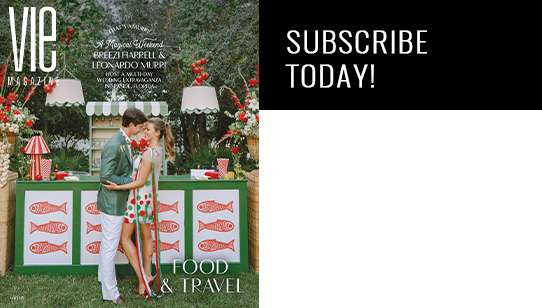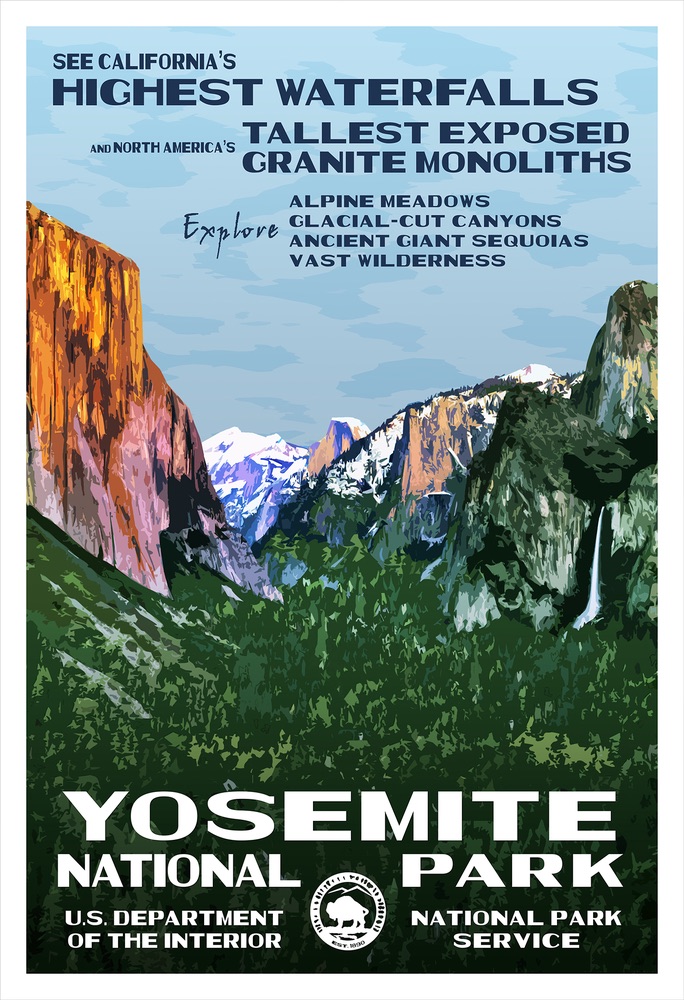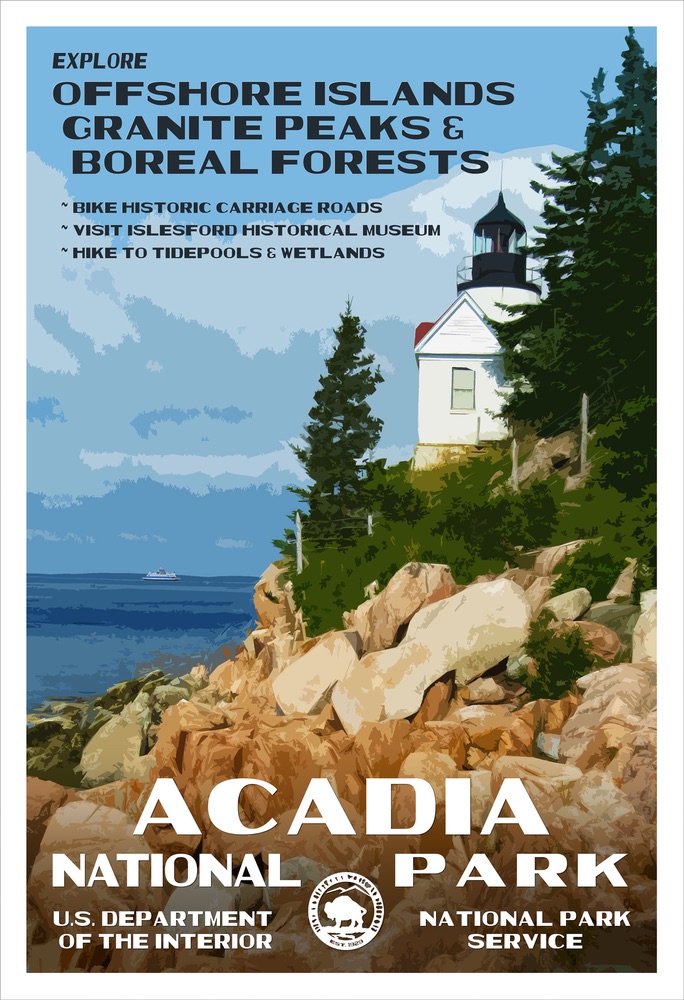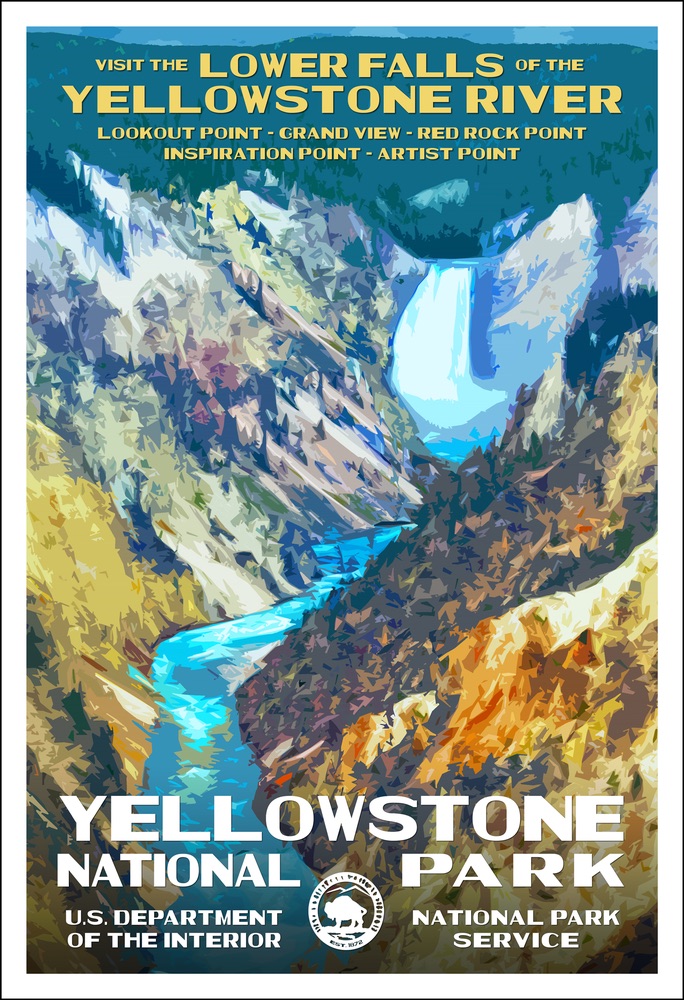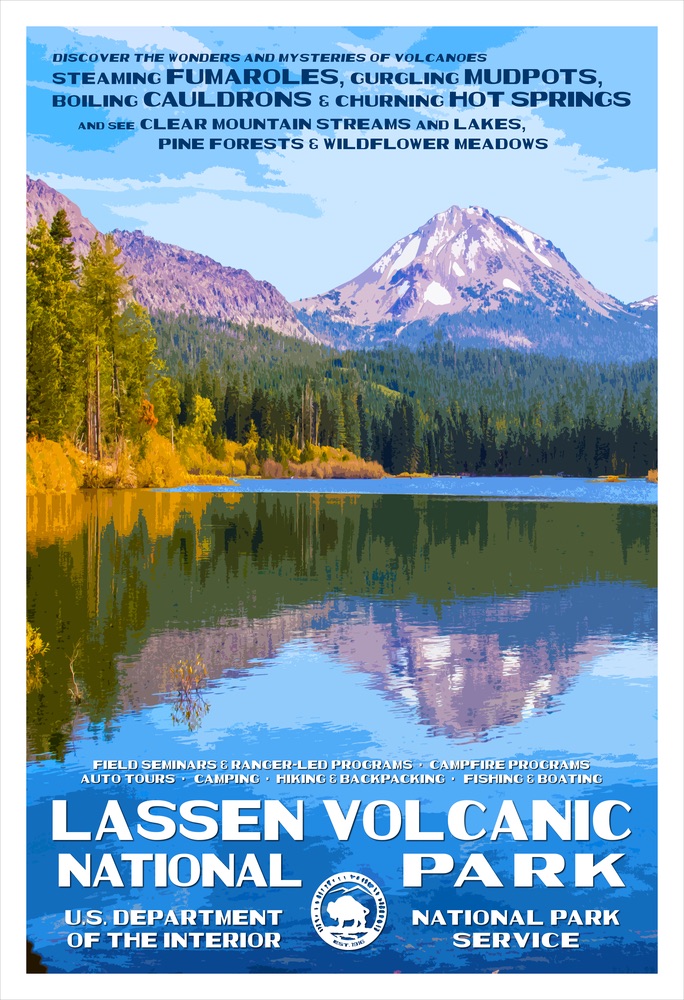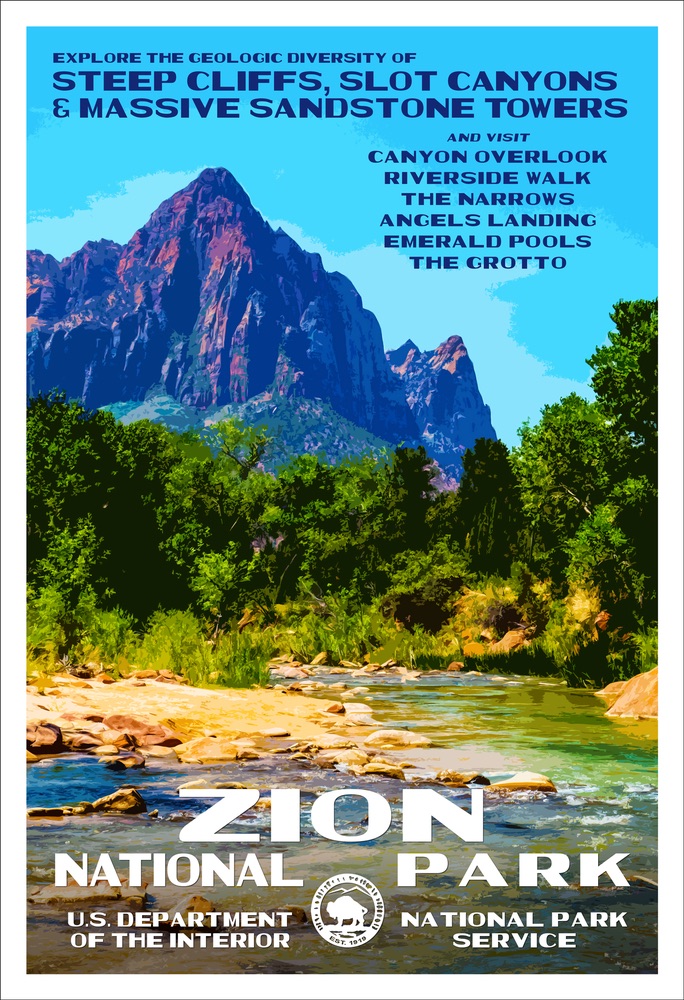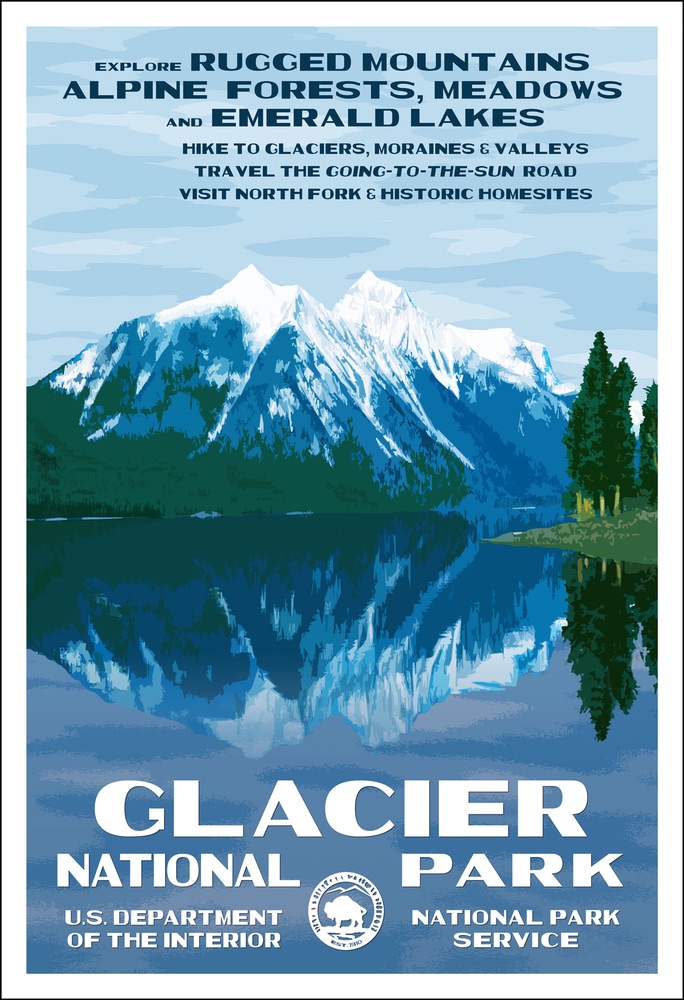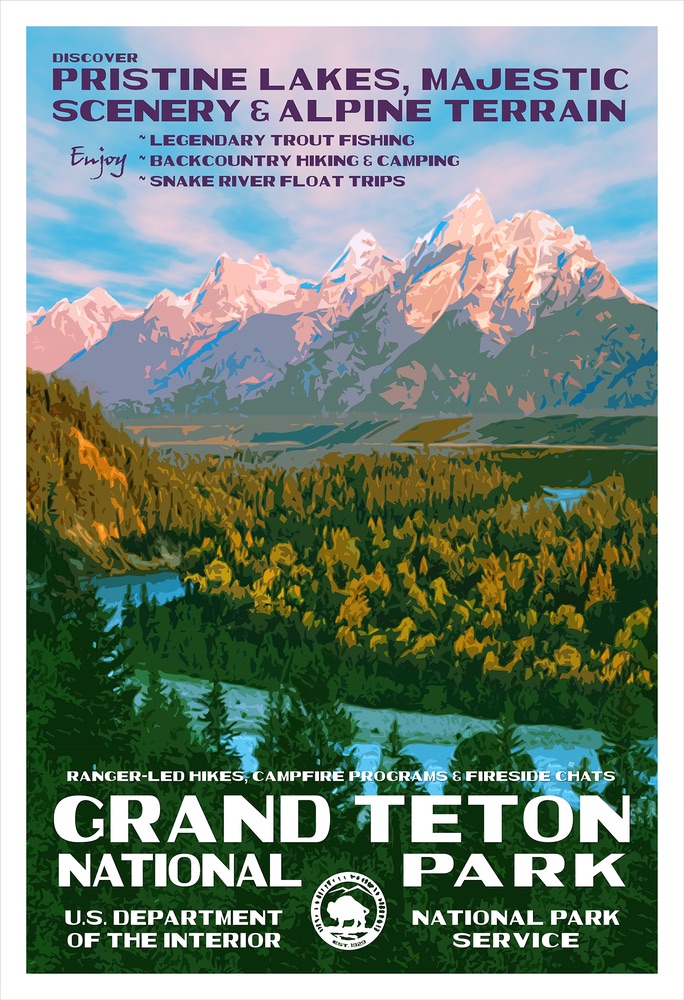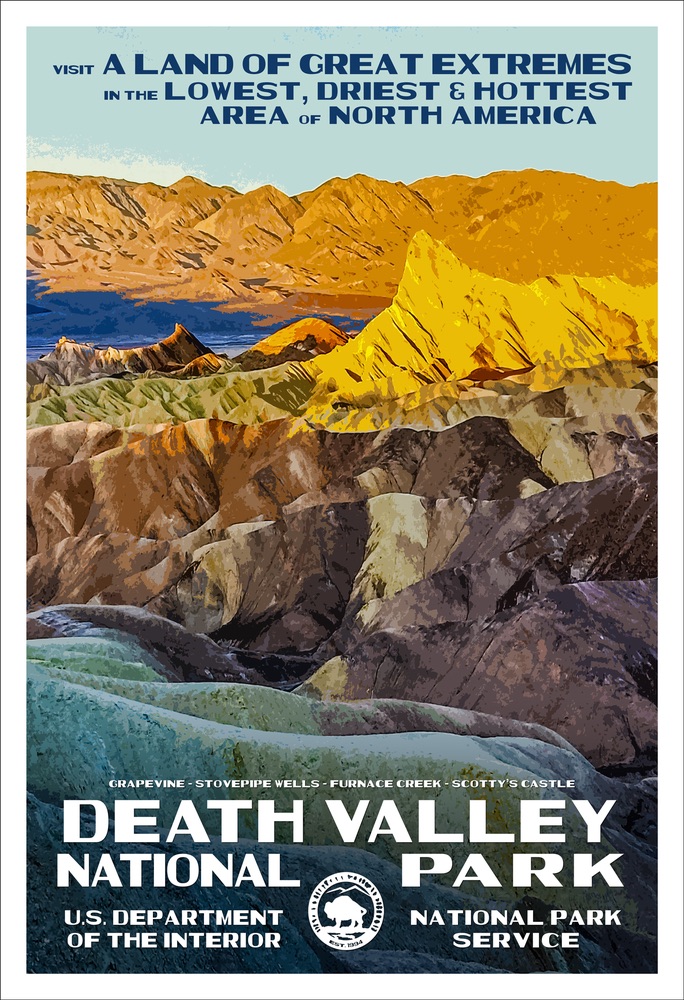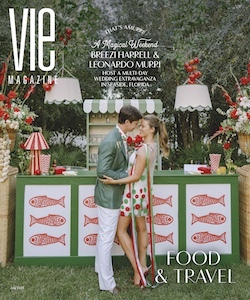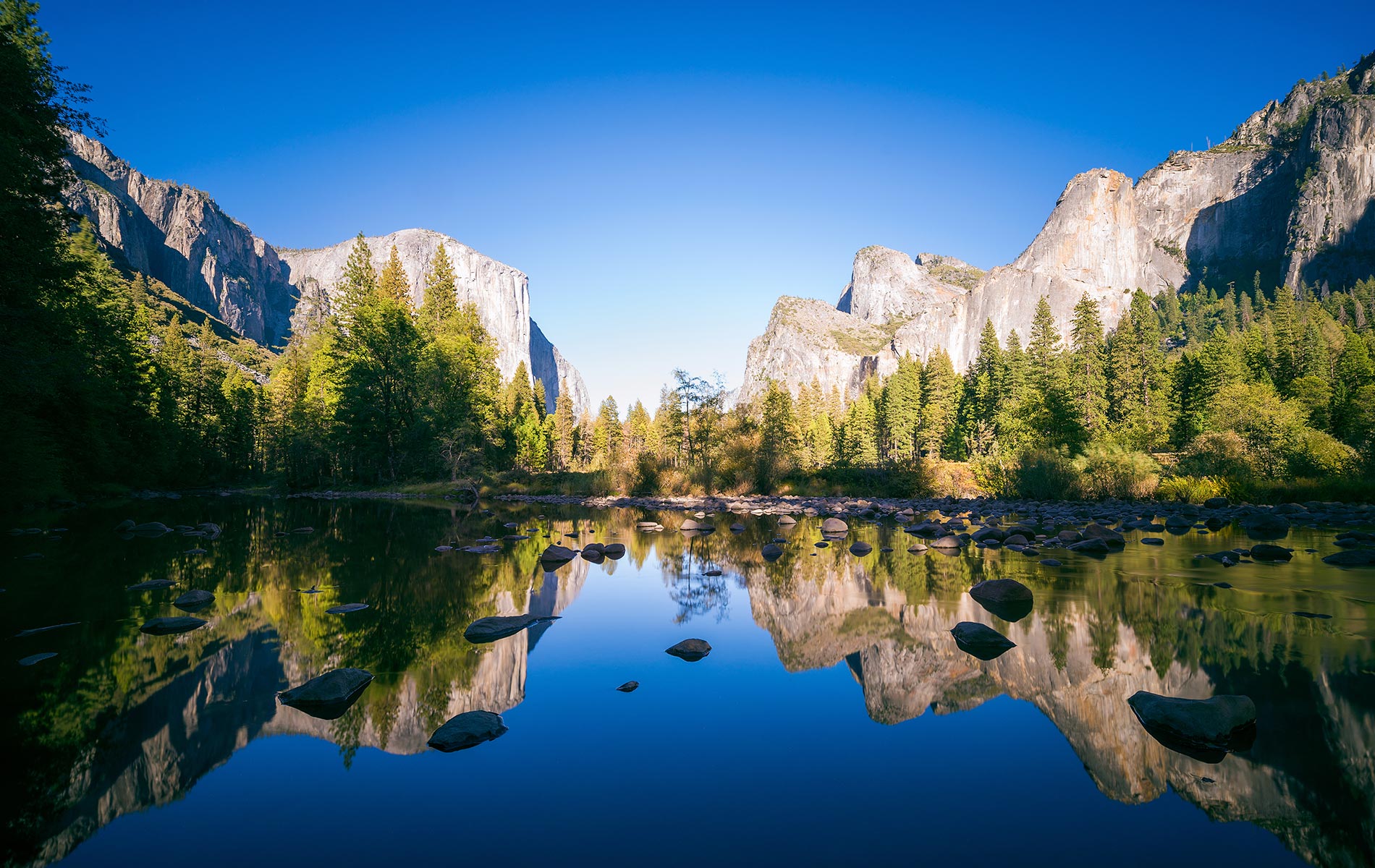
vie-magazine-national-park-posters-hero-min
An iconic view of Yosemite National Park in California’s Sierra Nevada mountains
History and Nature Go Hand in Hand
The Art of Conservation
By Chad Thurman | Artwork by Rob Decker
The year was 1872, and the United States, still reeling from the Civil War, was near the end of what became known as Reconstruction. Social and political upheaval were in full swing throughout the country, particularly the war-torn and battle-scarred land of the South. President Ulysses S. Grant, inspired by the second westward expedition of geologist Ferdinand V. Hayden, photographer William Henry Jackson, and landscape painter Thomas Moran, signed into law a bill creating the first national park, Yellowstone.
After the 1890 designation of many more national parks, but most notably the second great national park, Yosemite, Sierra Club cofounder and noted preservationist John Muir famously remarked, “There is a love of wild nature in everybody.” This sentiment would set the tone for the continued appreciation and conservancy of the landscape of the United States while simultaneously healing the wounds of the Civil War by recognizing and protecting the natural beauty of the land that had remained untouched by its ravages.
Years later, during the Great Depression, the New Deal created the Works Progress Administration (WPA) to employ Americans in public works projects. The WPA’s Federal Art Project hired thousands of artists to create pieces of art, including posters that publicized everything from public health to theater productions to travel. As many more national parks were created or enhanced, the opportunity to share the beauty of these lands was recognized, and WPA-style art became a vehicle by which this end was accomplished.
Fast-forward to today as photographer and graphic artist Rob Decker revisits and re-creates the style of these iconic WPA posters through his unique and modern take on what has become a wholly American style of art.
Decker grew up in Northern California, a few hours from Yosemite, and his family camped and explored there often. He was eight years old when he went on a ten-thousand-mile cross-country trip with his family in a motor home as they visited several national parks. He used a Kodak Duaflex camera with black-and-white 120 roll film to photograph the trip. He hadn’t put his future together at that point, but he enjoyed the photography side as well as the nature side of the experience, which later became the essence of his current art and ultimately his passion project.
“I was into photography as a kid,” Decker says. “In elementary school, I used to skip Spanish class to work in the darkroom with the science teacher. I also worked as a photographer for my high school yearbook.”
Throughout his career, Decker has owned a photography business doing everything from portraits to product shots and live performances. He has spent the past twenty-five-plus years as an independent consultant and producer involved in interactive programming, multimedia software and web development, educational textbook publishing, and graphic design. Decker says, “The real catalyst that brought everything together was the summer of 1979 when I studied under Ansel Adams in Yosemite National Park.” This, he shares, was the experience that solidified his love of photography and the national parks. “Adams hosted these workshops in Yosemite, and I went through an extensive application process, submitting work, and it was almost like applying to college and waiting to hear if you were accepted. I was fortunate enough to be accepted, and then it was several weeks in Yosemite with Adams.”
Decker says that this opportunity was an extended program of instruction and working directly with Adams in different parts of the park, attending lectures, and also being able to work with other notable photographers of the time.
He has spent the past twenty-five-plus years as an independent consultant and producer involved in interactive programming, multimedia software and web development, educational textbook publishing, and graphic design.
“It’s coming up on forty years ago, and I have to say that I think I value that experience more today than I did when I was nineteen years old. It was an amazing experience in that I got to spend time working with Adams out in the field in the Yosemite Valley and up in the Sierra Nevada high country. We did a lot of experimental stuff with Polaroid film.” (Adams was a friend of scientist and inventor Edwin Land, the inventor of the Polaroid camera and film).
“We had all of this Polaroid film and cameras, so we did all kinds of interesting experimental projects with them,” Decker continues. “I also got to spend time with him in the darkroom. His big thing was the Zone System, which was his photographic technique for determining the optimal exposure and development of film. I think that this is in large part why his photographs are so impressive—he was a master at creating the right exposure and then being able to manipulate that further in the darkroom.”
Decker notes that some of the most important lessons that he learned during this experience came after the day’s work was done.
“After the workday was finished, there was time in the evenings when there would be these cocktail parties with Adams and his wife, Virginia, and there were other photographers—not necessarily of his caliber, but there were other photographers who were a part of this program—and it was awe-inspiring and motivating for me as a young man to be around these artists.”
In retrospect, Decker believes that the entire experience was ultimately one of complete serendipity. He was in between colleges at the time, and this was something that got him on the right track as an artist and a professional photographer. It was not long after the Adams experience that he applied to and was accepted at the University of Colorado at Boulder, where he finished his college career and received his bachelor’s in communication.
“It was one of those things where being a professional photographer, especially at a young age, was a daunting career path, and so I did a lot of other things that would be considered stable—to pay the bills, to raise a family, and all of that good stuff.”
The switch into what Decker calls the National Park Poster Project started with his daughter’s wedding.
“She found this retro dress, and I made up all of the save-the-date cards and the table cards and created a poster with shots that I had taken around Colorado, and I did it in this WPA retro style. We joke about this today, that even though this was supposed to be her day, I got a lot of positive feedback about all of the artwork, and so I decided to take the leap. I tested the waters to see if I could leave my day job, my career, in the rear-view mirror and pursue my passion for photography and the national parks.”
Every park has something different, something new. It’s fun to explore, to get out the camera and hike around and see some new things. This really is a passion for me as I love the national parks, and they offer a lot to so many people.
Decker ran three successful crowdfunding campaigns through Kickstarter, and this became the true “proof of concept” that his idea was a viable project and more than just family flattery. Most importantly, the campaigns proved that a lot of people enjoyed his style of artwork.
As of today, there are fifty-three unique posters within Decker’s portfolio. Some of the imagery goes back to the 1970s when he graduated from high school and went on a big road trip with friends. They visited several national parks along their path. Decker saved the photos from this trip, and after his successful crowdfunding campaigns to start the project, he went back into his archives and started from there.
Now that this has become a full-time project, he has since revisited some of the parks to try to capture the “iconic shot” that would represent each one for the poster. He also has had the opportunity to visit many parks that he hadn’t been to before.
“Every park has something different, something new. It’s fun to explore, to get out the camera and hike around and see some new things. This really is a passion for me as I love the national parks, and they offer a lot to so many people.”
Decker gives back 10 percent of the profits from the sale of his prints to a wide array of organizations supporting national parks.
“It’s not easy to give directly to the National Park Service or to a specific national park, but each one either has its own conservancy, trust, or association, or there are some bigger groups that have a lot of parks under their umbrella. So I give back to the National Park Foundation, Yellowstone Forever, and the Glacier National Park Conservancy. Last year, after Hurricane Maria, I did a fund-raiser for the Friends of Virgin Islands National Park, which got hammered pretty hard by that storm. It seems that people appreciate this, too, as I seem to get a lot of good response from people who are feeling good that a part of their purchase is going to support these parks.”
The artist’s works are printed on a paper stock by Neenah called Conservation, which is 100 percent recycled. Most printing inks are petroleum based, so to take his mission further, Decker uses soy-based inks. He also employs a printer in Colorado that is exceptionally green and Rainforest Alliance Certified. Decker says, “These aspects of the printing process really fit in with the idea of the whole project here.
“My hope is that by creating these kinds of iconic images, I can help to generate some awareness for these places. I want to showcase not only the country’s amazing landscapes but also the rich history and vibrant culture that go along with them,” Decker says. “I think that everybody today—and in the future—should have the opportunity to enjoy our national parks, and creating the next generation of national park stewards is going to be important. We’re going to need people to put in government to help to keep these parks funded, as they’ve been underfunded for many years, and it’s not just by the current administration. These parks, our national treasures, could use all the help they can get.”
— V —
For more information on Rob Decker and his art, visit National-Park-Posters.com.
Share This Story!
KEEP UP WITH THE LATEST STORIES FROM VIE


